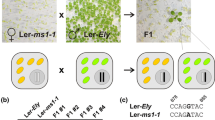Summary
Crossing experiments were conducted to determine whether parental genotype affected the rate of transmission of paternal mitochondria to progeny in rapeseed (Brassica napus). Progeny were screened either by RFLP analysis of mitochondrial (mt) DNA or by means of a mt marker that causes male sterility. To date we have transferred paternal mitochondria to progeny in only cross, i.e. a specific female line crossed to a specific male line. The male line carries the polima cytoplasm, the mitochondria of which confer a characteristic malesterile flower morphology when in a napus nuclear background. This line is male fertile due to a restorer gene carried on an extra chromosome from a closely related species, Brassica juncea. The female line has a Brassica campestris cytoplasm with a chloroplast mutation conferring resistance to triazine herbicides. Progeny with mixtures of parental mtDNA display a range of plant phenotype from complete male fertility through varying proportions of male-sterile sectors to complete male sterility. The male sterility or fertility of flowers on a sector of a plant reflects the mt population of that sector, and such sectors will give rise to stably fertile or sterile progeny. These experiments suggest that maternal inheritance of mitochondria in higher plants is due to genes active in both the pollen parent and the egg parent.
Similar content being viewed by others
References
Connett MB (1987) Mechanisms of maternal inheritance of plastids and mitochondria: Developmental and ultrastructural evidence. Plant Mol Biol Rep 4:193–205
Cornu A, Dulieu H (1988) Pollen transmission of plastid DNA under genotypic control in Petunia hybrida. Hortic J Hered 79:40–44
Erickson L, Kemble R (1990) Paternal inheritance of mitochondria in rapeseed (Brassica napus). Mol Gen Genet 222:135–139
Erickson L, Kemble R, Swanson E (1989) The Brassica mitochondrial plasmid can be sexually transmitted. Pollen transfer of a cytoplasmic genetic element. Mol Gen Genet 218:419–422
Kemble RJ (1987) A rapid, single leaf, nucleic acid assay for determing the cytoplasmic organelle complement of rapeseed and related Brassica species. Theor Appl Genet 73:364–370
Massoud SA, Johnson LB, Sorensen EL (1990) High transmission of paternal plastid DNA in alfalfa plants demonstrated by restriction fragment polymorphic analysis. Theor Appl Genet 79:49–55
Mizushima U (1980) Genome analysis in Brassica and allied genera. In: Tsunoda S, Hinata K, Gomez-Campos C (eds) Brassica crops and wild allies. Japan Scientific Societies Press, Tokyo, pp 89–106
Reith M, Straus NA (1987) Nucleotide sequence of the chloroplast gene responsible for triazine resistance in canola. Theor Appl Genet 73:357–363
Swanson EB, Coumans MP, Wu Sc, Barsby TL, Beversdorf WD (1987) Efficient isolation of microspores and the production of microspore-derived embryos from Brassica napus. Plant Cell Rep 6:94–97
Author information
Authors and Affiliations
Rights and permissions
About this article
Cite this article
Erickson, L., Kemble, R. The effect of genotype on pollen transmission of mitochondria in rapeseed (Brassica napus). Sexual Plant Reprod 6, 33–39 (1993). https://doi.org/10.1007/BF00227580
Issue Date:
DOI: https://doi.org/10.1007/BF00227580




